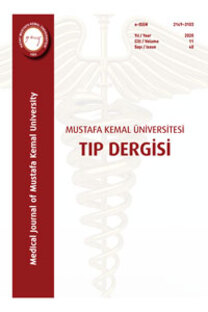Erkek Meme Kanseri: Tek Merkez Deneyimi
Aksiller Lenf Nodu Diseksiyonu, Erkek Meme Kanseri, Segmental Mastektomi, Sentinel Lenf Nodu Biyopsisi
Male Breast Cancer: A Single-Center Experience
Axillary Lymph Node Dissection, Male Breast Cancer, Segmental Mastectomy, Sentinel Lymph Node Biopsy,
___
- Donegan WL, Redlich PN. Breast cancer in men. Surg Clin North Am. 1996 Apr;76(2):343-63. https://doi.org/10.1016/s0039-6109(05)70443-6
- Fentiman IS, Fourquet A, Hortobagyi GN. Male breast cancer. Lancet. 2006 Feb 18;367(9510):595-604. https://doi.org/10.1016/S0140-6736(06)68226-3
- Fisher B, Bauer M, Wickerham DL, Redmond CK, Fisher ER, Cruz AB, Foster R, et al. Relation of number of positive axillary nodes to the prognosis of patients with primary breast cancer. An NSABP update. Cancer. 1983 Nov 1;52(9):1551-7. https://doi.org/10.1002/1097-0142(19831101)52:9<1551::aid-cncr2820520902>3.0.co;2-3
- D’Eredita G, Giardina C, Guerrieri AM, Berardi T. A further validation of subareolar injection technique for breast sentinel lymph node biopsy. Ann Surg Oncol. 2006 May;13(5):701-7. https://doi.org/10.1245/ASO.2006.04.027
- Díaz Brito JA, Navarrete SV, Muñoz JA, Guardiola YS, Sánchez JG, Ruiz VV, et al. Sentinel node biopsy in early breast cancer at the Hospital Comarcal La Linea (Spain). Ecancermedicalscience. 2013 Sep 23;7:353. https://doi.org/10.3332/ecancer.2013.353
- Cejalvo JM, Pascual T, Fernández-Martínez A, Brasó-Maristany F, Gomis RR, Perou CM, Muñoz M, Prat A. Clinical implications of the non-luminal intrinsic subtypes in hormone receptor-positive breast cancer. Cancer Treat Rev. 2018 Jun;67:63-70. https://doi.org/10.1016/j.ctrv.2018.04.015 Speirs V, Shaaban AM. The rising incidence of male breast cancer. Breast Cancer Res Treat. 2009 May;115(2):429-30. https://doi.org/10.1007/s10549-008-0053-y
- Zygogianni AG, Kyrgias G, Gennatas C, Ilknur A, Armonis V, Tolia M, et al. Male breast carcinoma: epidemiology, risk factors and current therapeutic approaches. Asian Pac J Cancer Prev. 2012;13(1):15-9. https://doi.org/10.7314/apjcp.2012.13.1.015
- Leone, J.P., Leone, J., Zwenger, A.O., Iturbe, J., Vallejo, C.T. and Leone, B.A. Prognostic significance of tumor subtypes in male breast cancer: a population-based study. Breast Cancer Res Treat. 2015;152:601–609 https://doi.org/10.1007/s10549-015-3488-y
- Anderson WF, Althuis MD, Brinton LA, Devesa SS. Is male breast cancer similar or different than female breast cancer? Breast Cancer Res Treat. 2004 Jan;83(1):77-86. https://doi.org/10.1023/B:BREA.0000010701.08825.2d
- Cardoso F, Bartlett JMS, Slaets L, van Deurzen CHM, van Leeuwen-Stok E, Porter P, et al. Characterization of male breast cancer: results of the EORTC 10085/TBCRC/BIG/NABCG International Male Breast Cancer Program. Ann Oncol. 2018 Feb 1;29(2):405-417. https://doi.org/10.1093/annonc/mdx651
- Anderson WF, Jatoi I, Tse J, Rosenberg PS. Male breast cancer: a population-based comparison with female breast cancer. J Clin Oncol. 2010;28(2):232-239. https://doi.org/10.1200/JCO.2009.23.8162
- Kiluk JV, Lee MC, Park CK, Meade T, Minton S, Harris E, Kim J, Laronga C. Male breast cancer: management and follow-up recommendations. Breast J. 2011 Sep-Oct;17(5):503-9. https://doi.org/10.1111/j.1524-4741.2011.01148.x
- Gentilini O, Chagas E, Zurrida S, Intra M, De Cicco C, Gatti G, et al. Sentinel lymph node biopsy in male patients with early breast cancer. Oncologist. 2007 May;12(5):512-5. https://doi.org/10.1634/theoncologist.12-5-512
- Flynn LW, Park J, Patil SM, Cody HS 3rd, Port ER. Sentinel lymph node biopsy is successful and accurate in male breast carcinoma. J Am Coll Surg. 2008 Apr;206(4):616-21. https://doi.org/10.1016/j.jamcollsurg.2007.11.005
- Hill AD, Borgen PI, Cody HS 3rd. Sentinel node biopsy in male breast cancer. Eur J Surg Oncol. 1999 Aug;25(4):442-3. https://doi.org 10.1053/ejso.1999.0674
- Cimmino VM, Degnim AC, Sabel MS, Diehl KM, Newman LA, Chang AE. Efficacy of sentinel lymph node biopsy in male breast cancer. J Surg Oncol. 2004 May 1;86(2):74-7. https://doi.org/10.1002/jso.20045
- Albo D, Ames FC, Hunt KK, Ross MI, Singletary SE, Kuerer HM. Evaluation of lymph node status in male breast cancer patients: a role for sentinel lymph node biopsy. Breast Cancer Res Treat. 2003 Jan;77(1):9-14. https://doi.org/10.1023/a:1021173902253
- Boughey JC, Bedrosian I, Meric-Bernstam F, Ross MI, Kuerer HM, Akins JS, et al. Comparative analysis of sentinel lymph node operation in male and female breast cancer patients. J Am Coll Surg. 2006 Oct;203(4):475-80. https://doi.org/10.1016/j.jamcollsurg.2006.06.014
- Martin-Marcuartu JJ, Alvarez-Perez RM, Sousa Vaquero JM, Jimenez-Hoyuela García JM. Selective sentinel lymph node biopsy in male breast cancer. Rev Esp Med Nucl Imagen Mol (Engl Ed). 2018 May-Jun;37(3):146-150. English, Spanish. https://doi.org/10.1016/j.remn.2017.09.004
- ISSN: 2149-3103
- Yayın Aralığı: 3
- Başlangıç: 2010
- Yayıncı: Hatay Mustafa Kemal Üniversitesi Tıp Fakültesi Dekanlığı
Bir Tıp Fakültesi Öğrencilerinin Yaşlı Ayrımcılığına İlişkin Tutumlarının Belirlenmesi
Büşra KARABEKİROĞLU, Celal KUŞ, Raziye GÜMÜŞTAKIM
Orak Hücre Anemili Hastalarda Osteoporoz ile İlişkili Biyokimyasal Markerlerin Tanıdaki Yeri
Meryem KORKMAZ, Berna KUŞ, Emre DİRİCAN, Abdullah ARPACI
COVID-19 Pnömonisi ve Akut Böbrek Hasarı: Hemodiyaliz Tedavisi
Üst Gastrointestinal Sistemde Yabancı Cisimlerin Değerlendirilmesi: Tanı ve Tedavi
Hasan ÇANTAY, Turgut ANUK, Barlas SÜLÜ, Kenan BİNNETOĞLU, Tülay ALLAHVERDİ, Doğan GÖNÜLLÜ
Suna SARIKAYA, Sedat YAŞİN, Mustafa ÇALIK, Tahir YOLDAŞ
Hülya DURAN, Nihan CEKEN, Bülent ATİK
Crohn Hastalığı ve Membranöz Glomerulonefrit Olgu Sunumu
Can HÜZMELİ, Murat GÜLLÜ, Kazım ÖZTÜRK, Yılmaz CANIM, Yasin KILINÇ, İbrahim YILMAZ
